To Guide or Not to Guide: The Official Nintendo Player's Guide (1987, Tokuma Shoten)
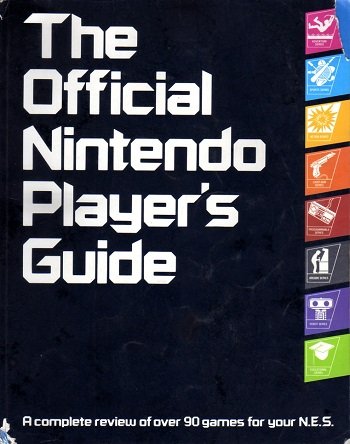
Welcome back my fellow geeks and gaming historians to another installment of "To Guide or Not to Guide", the series which looks at the processed tree corpses of bygone decades devoted to video games, and then attempts to influence your purchasing habits.
I took a break from this for a little while, but I was doing some cleaning in the office and ran across this little gem. In fact, that's a direct cover scan of my book right there: corners torn, edges dinged, spine bent from weeks spent in backpacks and school desks, and loved only the way a thirty year old rectangular paper stuffed animal analog could be. I was nine years old when this book came out, available both at retail stores or packaged with certain versions of the Nintendo Entertainment System, and the effect it had on my young self cannot be understated. This was, for millions of kids all over the US, the most important book any of us could possibly imagine: screenshots, maps, stickers, tips, hints, and strategies for "[o]ver 90 games for your N.E.S." as the cover promised. Outside of actually playing the games themselves, what more could any kid want?
But I'm forty years old now, a jaded survivor of the Console Wars, and those rose-colored nostalgia lenses are making my face itch. So while this was the most mind-blowing tome imaginable in my formative years, I've had three intervening decades to look back on and process. Let's see what happens when I crack that cover and dive into the fray for this amazing, astonishing, unauthorized, uncensored, and unofficial look at The Official Nintendo Player's Guide, from the desk of Howard Phillips to my own bookshelf.
Press Start
Most print-oriented products from Nintendo opened with some sort of letter to the player who would soon be making use of the book, magazine, or game cartridge they had just purchased. The Official Nintendo Player's Guide is no exception, as the first of its 162 full-color pages is a giant welcoming letter from Nintendo to the reader, explaining what the book is all about and how it's going to turn you from amateur ass-kicker to professional program punter. It also unfortunately provides the first of multiple embarrassing gaffes that the company would become known for during their formative marketing years:
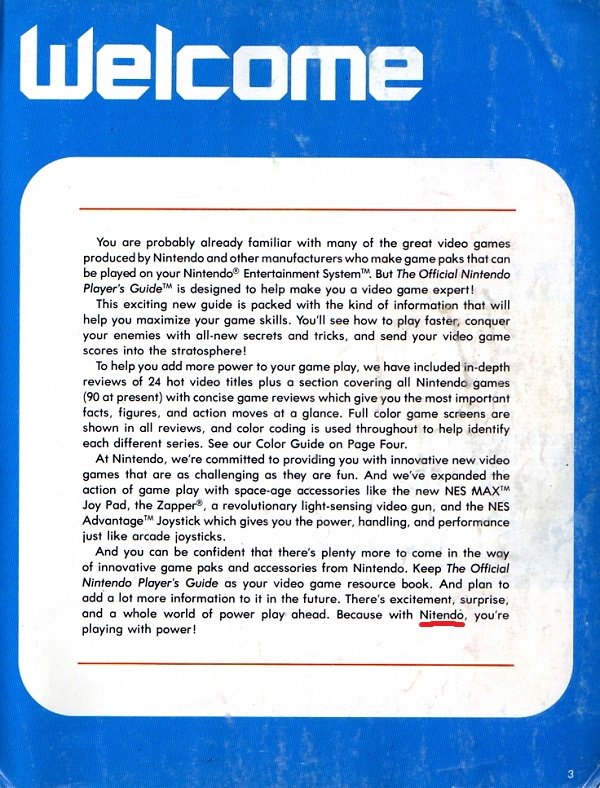
I underlined it in case you missed it in all the excitement.
Screw-ups like these were not only legendary in supplementing 'Engrish as a Second Language' talents among American youth, but also provided ammo for agitated parents, educators, and adults to claim that those darn Japanese video games were undermining the intelligence of their kids. Nintendo eventually got their act together and hired native English speakers to proofread and edit their content, but their presence in the US in the mid-80's was too small to allow for this luxury, and mistakes like this were legion at the start. I'm not saying everything needs to be perfect--even today you can find plenty of spelling mistakes and grammar errors in professionally-published native English works. I catch myself messing up all the time.
But to misspell your own company's name on the very first page of your very first major publication, and not notice it until after it went to print? That's a textbook definition of 'failure' you'd see spread all over social media within seconds of its release into the wild.
Want to know what's funny though? As a kid, I never noticed this. My friends never noticed this. You never noticed this.
No child anywhere noticed this.
As a kid, you read the book to learn about video games, not a lesson in making hilarious marketing blunders. I don't even remember reading the welcome letter prior to today, and I've owned this thing for three-quarters of my life. About the best thing you can say for it is that it isn't signed, so it's impossible to assign blame to any one individual.
But that's enough malarkey about a text box nobody paid attention to. Let's get to the meat. There's 90 games between these covers we need to cover, so better get started.
Stage 1 - 1
You know, come to think of it, 162 pages seems an awfully small amount required to devote to a "complete review" of nearly one hundred pieces of software. I'm no math ace, but I can pull up a calculator app with the best of them, and it tells me that's a mere 1.8 pages per game. 'Less than two pages' leaves a bit to be desired when it comes to a 'complete review'. What's going on here?
It's not new math, just a reinterpretation of what qualifies as a 'complete review'. Of the software it covers, twenty-four games get the full treatment of in-depth coverage. The remainder of the carts discussed are broken down in a three-to-a-page format that amounts to little more than ad copy featuring the box art and 2-3 screenshots.
Sneaky, sneaky, Nintendo. Good thing the twenty-four games that did get the 'complete review' treatment are among the best titles on the system at time of publication, otherwise we never would have forgiven you.
Stage 1 - 2
So, what titles were deserving of coverage? Check it out:
- The Legend of Zelda
- Mike Tyson's Punch-Out!!
- Commando
- Super Mario Bros.
- Ghosts 'N Goblins
- Top Gun
- Double Dribble
- Zelda II: The Adventure of Link
- Metroid
- Rad Racer
- Ring King
- Gradius
- Kid Icarus
- Pro Wrestling
- Castlevania
- Excitebike
- Arkanoid
- Rush 'N Attack
- Donkey Kong
- Rygar
- Spy Hunter
- The Goonies II
- Ikari Warriors
- Kung Fu
Clearly some of these games deserved more page space than others. Spy Hunter and Double Dribble, for instance, merit only two-page write-ups because there's not a whole lot to them. On the other hand, the massive, complex games like Metroid and The Legend of Zelda which feature maze-like stages, varied power ups, and large rosters of enemies have eight pages devoted to them.
That doesn't mean Nintendo's going to lift up every game's skirt all the way--they give a full Overworld map for Zelda, but only provide dungeon maps up through level six, for instance--but what they do show off is generally enough to whet a living-room-warrior's appetite for the experience. I didn't realize it until taking a closer look at it as an adult, but this is actually a pretty effective marketing technique too. No parent wants to drop $50 or more on a new game only to have their kid come back in a week and beg for a new game because they just beat it and want a different challenge. Looking at the sprawling complex depicted in Metroid, with its different areas and paths and shortcuts, subtly whispers, "This will keep your progeny occupied for months!"
More bang for your buck is always a good thing, and Nintendo's careful to play to this strength whenever possible. "Look at all we can show you," the guide says, "and then think: there's even more than that!" Nintendo weren't idiots--they implemented a call-in hint line which employed Game Counselors who gave out hints and strategies for every game in their roster, but they always instructed their Counselors to stop short of revealing everything. After all, if a quick phone call to Washington state could tell you how to beat Gannon or send Tyson down for the ten-count, that removed some of the mystique.
Nintendo eventually reversed this policy with the publication of cheat books and walkthroughs for specific carts, starting with Super Mario Bros. and The Legend of Zelda, then moving on to other hits like Final Fantasy and Super Mario Bros. 3 via full-length special issues of Nintendo Power, but early on, never giving away the final parts of games ensured kids still had to do some of the work themselves. Whether this was due to competition from other sources like GamePro or Electronic Gaming Monthly who were perfectly happy to spoil puzzles and give away the mystery, or Nintendo realized that the sooner kids beat the games they played, the sooner they were asking for new ones isn't clear. But this is 1987, and this Player's Guide was no full walkthrough, even in its most in-depth coverage.
If you wanted that, you'd need to wait until 1991 for the publication of The NES Game Atlas, a book I'll get around to covering in good time. But for now, even these complete reviews are just appetizers on an epic silicon buffet. They didn't hesitate to lie to readers to keep the mystique intact either, something especially clear in the Metroid write-up where Samus is constantly referred to as 'he' and 'him' so as to keep gamers in the dark up until they cleared the game fast enough to learn the truth.
Warp Zone
One of the book's strongest selling points is its massive maps and full-color presentation. While the instruction booklets for NES games were little rectangles usually printed in black-and-white, The Official Nintendo Player's Guide was a full-sized book which did more to summarize the enemies, power-ups, and stages than its comparatively tinier counterparts. Take a look at this hand-drawn map of Brinstar from Metroid, for instance:
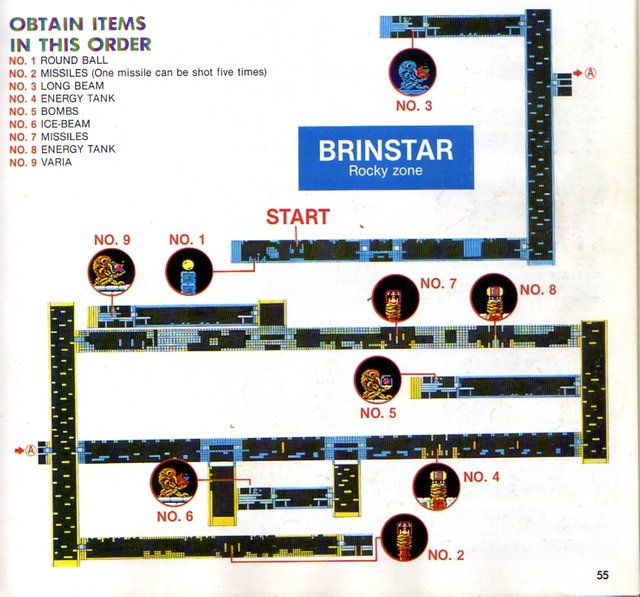
Nintendo is noted for using screenshots to piece together their maps in publications like Nintendo Power and their Fun Club newsletter, but those haven't come to full form yet. Despite this, enemies, power-ups, and friends in this book are all depicted with their official sprites taken from screen snaps. Maps, on the other hand, are largely hand-drawn when present, but if you compare them to the actual in-game structures, you'll find very little to complain about since they're so exacting.
Unfortunately the translation from its Japanese counterpart combined with Nintendo of America's desire to soften everything to be kid-friendly sometimes results in unintentionally amusing linguistics. One of my favorites is this description of an enemy from the Commando section:
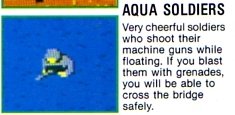
Well, he may be trying to murder me, but at least he's cheerful about it. Ain't it great when someone loves his job?
The other thing you'll notice, especially in the "Game Guide" section is the creative liberties taken by the writers and/or translators when it comes to providing back-stories, especially for games that didn't have them to begin with. As an example, Data East's Karate Champ was about a nameless challenger competing in a karate tournament against other nameless opponents, where each round was a best-of-three battle. At least, that's what it was about in the arcade version. According to the ad copy writers for the NES home version, Karate Champ's premise was something else entirely:
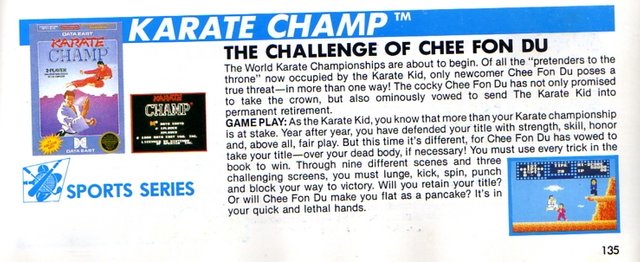
I just... "Chee Fon Du"? Really, Nintendo...?
Final Boss
If it wasn't clear by now, The Official Nintendo Player's Guide was the Holy Grail for NES fanatics in the mid-to-late 80's. Having a copy was an instant path to friendship with half a dozen other video wizards on the school playground, and I'm far from alone in my experience of poring over it in lieu of other important tasks like homework.
Still, when looked at by today's standards, the book's not exactly setting the world on fire. It's neat, but it's neat in the same way a replica of an early Ford Model-T is neat. It's more important nowadays as a way to see just how far we've come from the early days. As an artifact from a bygone era and a testament to bygone policies of a video game company who is still around three decades later, its important cannot be understated.
The disappointing (and somewhat shocking) reality though is that trying to acquire one is going to cut deeply into your ramen and chill budget. Copies on the secondhand market routinely sell for over $50, and as of this writing the least-expensive one I could find on Amazon clocked in at just under $90. That's insane--the book's cool, but not "skipping a few meals" cool unless you're a die-hard Nintendo collector or gaming historian. Find it in decent shape for around $20, and I'd say you've got a great option for purchase, especially if the sticker sheet is still intact.
"Sticker sheet?" you ask.
"Sticker sheet," I reply confidently.
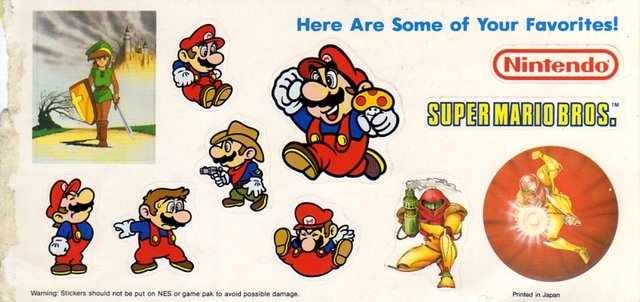
Well, heck, that changes everything, doesn't it?
Damn it! I wrote an entire post about how you depress the hell out of me with your nostalgic awesomeness but then hit the wrong key and it all went away.... Well re-typing it all would be a pain in my butt so I will just say kudos in creating the perfect storm or fond memories and depressive yearnings.
damn I miss the old NES days, I even miss the honorableness of Pro Wrestling :-)
Hey, @deadmoonwrites! Great to see you down here in the comments again. I hope I don't really activate your depression with posts like these. It's just some, uh, serious fun. You're welcome to join in any time! Heck, #gaming would welcome the boost to their tag numbers, I suspect. ;)
It's all good. actually I love reliving all my NES memories. Keep em coming. I might just have to write up a post or two using the #gaming tag..... thanks for the suggestion :-)
This thing was almost mythical amongst my peer group of Nitendo playing friends as a kid. There was one copy in the neighborhood and it was well before we had Nintedo Power. Even the font and graphics on the cover were unique, reminding me somehow of semi-official technical manuals, like the Hanes guides for our father's cars.
To listen to the audio version of this article click on the play image.

Brought to you by @tts. If you find it useful please consider upvoting this reply.